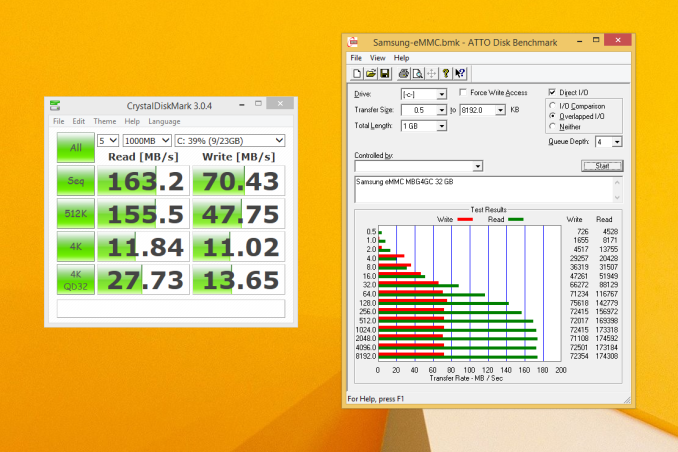Intel PPSTCK1A32WFC Bay Trail-T Compute Stick Review
by Ganesh T S on April 22, 2015 11:00 AM EST- Posted in
- Systems
- Intel
- Bay Trail
- HDMI Stick
Networking and Storage Performance
Evaluating the capabilities of the primary storage subsystem turned out to be a challenging process. We usually use PCMark 8's storage bench for mini-PCs. However, the lack of enough free space after installing a couple of Windows updates meant that PCMark 8 would consistently crash during the benchmark process. However, we were able to process the benchmark on the Patriot EP series microSDXC card.
The PCMark 8 storage bench replays the traces of certain common workloads such as loading games and document processing on the target drive. Results are presented in two forms, one being a benchmark number and the other, a bandwidth figure. We ran the PCMark 8 storage bench on selected PCs and the results are presented below.


Note that we are benchmarking a microSDXC card with write speeds of the order of 40 MBps and read speeds of around 90 MBps - the results are not surprising, and should only be taken at face value. That said, in order to get an idea of the eMMC performance, we ran ATTO and CrystalDiskMark on the Samsung MBG4GC. A screenshot of the results is presented below.
On the networking side, we restricted ourselves to the evaluation of the WLAN component. Our standard test router is the Netgear R7000 Nighthawk configured with both 2.4 GHz and 5 GHz networks. The router is placed approximately 20 ft. away, separated by a drywall (as in a typical US building). A wired client (Zotac ID89-Plus) is connected to the R7000 and serves as one endpoint for iPerf evaluation. The PC under test is made to connect to either the 5 GHz (preferred) or 2.4 GHz SSID and iPerf tests are conducted for both TCP and UDP transfers. It is ensured that the PC under test is the only wireless client for the Netgear R7000. We evaluate total throughput for up to 32 simultaneous TCP connections using iPerf and present the highest number in the graph below.

In the UDP case, we try to transfer data at the highest rate possible for which we get less than 1% packet loss.

The numbers appear downright bad even when we consider that we are looking at a 1x1 802.11n connection. Surprisingly, when connected to another router in the same place, we were getting transfer rates in the order of 48 - 50 Mbps. However, the results graphed above have the numbers from the same router with the clients at the same location. Users will probably be seeing a wide range in the performance of the WLAN component.











103 Comments
View All Comments
BMNify - Wednesday, April 22, 2015 - link
This is free windows license, windows with Bing is mentioned in the review which is provided free to OEM's.kyuu - Thursday, April 23, 2015 - link
Uh, except it is Windows with Bing. As mentioned in the article.Marc GP - Wednesday, April 22, 2015 - link
It's huge compared with the Asustek Chromebit, it can't be much comfortable to carry with you everywhere.No thank you. Put that capability on the phone instead (that I have no problem to always carry it).
tekeffect - Wednesday, April 22, 2015 - link
I considered preordering this. Thankfully I did not. Thanks for the review. Can anyone suggest the best device to use for plex on 4 k TV ? I would like as small as possible without massive sacrificesMarc GP - Wednesday, April 22, 2015 - link
Have you considered the Asus Chromebit ?http://www.cnet.com/products/asus-chromebit/
It's fanless, much smaller and powerful (specially the GPU, that is capable of 4k).
It comes with Chrome OS, but looks like there is a Plex app for Chrome.
Uplink10 - Thursday, April 23, 2015 - link
Google's Chrome OS can't even compare to Windows or Linux, it is more like a Thin client.Dug - Wednesday, April 22, 2015 - link
Too limiting for my needs. I just picked up an HP stream mini for $10 more.Yes it's bigger, but still fits in the palm of your hand. Added 8GB of ram and stuck to back of TV and good to go.
Lonyo - Wednesday, April 22, 2015 - link
It's also more versatile because it can be used without a TV since it has a screen.BMNify - Wednesday, April 22, 2015 - link
HP Steam Mini does not have a screen, you are confusing HP stream laptop with HP stream Mini desktop PC.Uplink10 - Thursday, April 23, 2015 - link
HP Stream Mini is also limited, you can't put in 2.5" drive without some additional cable.Better to buy Zotac miniPC (ZBOX ID18,...) or Gygabite BRIX with 4-core Bay Trail CPU and add additional 4GB RAM and 2.5" HDD.
You will pay: miniPC (120$) + RAM (35$) + HDD (45$) = 200$
But you will have much better hardware and BIOS which will undoubtedly support Legacy BIOS booting option and more options thatn HP Stream Mini.